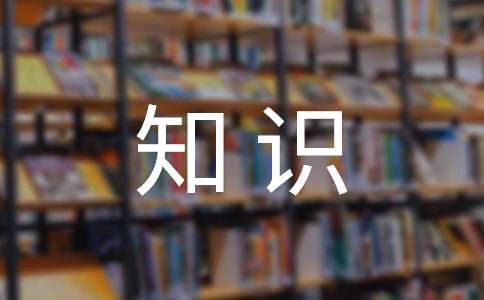基礎(chǔ)英語知識點大全
在我們平凡的學(xué)生生涯里,相信大家一定都接觸過知識點吧!知識點就是一些常考的內(nèi)容,或者考試經(jīng)常出題的地方。那么,都有哪些知識點呢?下面是小編收集整理的基礎(chǔ)英語知識點,歡迎閱讀與收藏。

第一部分、基礎(chǔ)知識
1.字母:26個字母的大小寫
大寫:ABCDEFGHIJKLMNOPQRSTUVWXYZ
小寫:abcdefghijklmnopqrstuvwxyz
2.語音:元音的發(fā)音 五個元音字母:AEIOU
12個單元音:長元音:/ɑ:/,/ :/,/ :/, /i:/,/u:/
短元音:/ / /e/ /i/ / / /∧/ /u/ / /
3.詞匯:詞匯量,近反義詞
4.句子:大小寫,標(biāo)點符號
第二部分、語法知識
一、名詞:名詞單復(fù)數(shù),名詞的格
(一)名詞單復(fù)數(shù)
1.一般情況,直接加-s,如:book-books, bag-bags, cat-cats, bed-beds
2.以s. x. sh. ch結(jié)尾,加-es,如:bus-buses, box-boxes, brush-brushes, watch-watches
3.以―輔音字母+y‖結(jié)尾,變y為i, 再加-es,如:family-families, strawberry-strawberries
4.以―f或fe‖結(jié)尾,變f或fe為v, 再加-es,如:knife-knives
5.不規(guī)則名詞復(fù)數(shù):
man-men,
woman-women,
policeman-policemen,
policewoman-policewomen, mouse-mice
child-children,
foot-feet,
tooth-teeth,
fish-fish,
people-people,
Chinese-Chinese,
Japanese-Japanese
不可數(shù)名詞的復(fù)數(shù)就是原型: paper, juice, water, milk, rice, tea
(二)名詞的格
1.有生命的東西的名詞所有格:
(1) 單數(shù)后加 ‘s 如: Lucy‘s ruler my father‘s shirt
(2)以s 結(jié)尾的復(fù)數(shù)名詞后加 ‘如: his friends‘ bags
(3)不以s 結(jié)尾的復(fù)數(shù)后加 ‘s children‘s shoes
并列名詞中,如果把 ‘s加在最后一個名詞后,表示共有;
如:Tom and Mike‘s car 湯姆和邁克共有的小汽車
表示所有物不是共有的,應(yīng)分別在并列名詞后加‘s.
如:Tom‘s and Mike‘s cars 湯姆和麥克各自的小汽車
2.表示無生命東西的名詞通常用― of +名詞‖來表示所有關(guān)系:
如:a picture of the classroom a map of China
二、冠詞:不定冠詞,定冠詞種類:
(一) 不定冠詞:a / an
元音讀音開頭的可數(shù)名詞前用an :
an egg / an apple / an orange / an eraser / an answer / an ID card / an alarm clock / an actor / an actress / an e-mail / an address / an event / an example / an opera / an hour an old man / an interesting book / an exciting sport / an action movie / an art lesson /
(二)定冠詞:the
定冠詞的用法:
1.特指某(些)人或某(些)物: The ruler is on the desk.
2.復(fù)述上文提到的人或物:He has a sweater. The sweater is new.
3.談話雙方都知道的人或物:The boys aren‘t at school.
4.在序數(shù)詞前: John‘s birthday is February the second.
5.用于固定詞組中: in the morning / afternoon / evening 不用冠詞的情況:
(1)專有名詞前:China is a big country.
(2)名詞前有定語:this , that , my , your , some, any , no 等:
This is my baseball.
(3)復(fù)數(shù)名詞表示一類人和事:Monkeys can‘t swim. They are teachers.
(4)在節(jié)日,日期,月份,季節(jié)前:Today is Christmas Day. It‘s Sunday.
(5)一日三餐前:We have breakfast at 6:30.
(6)球類 棋類運動前:They often play football after class. He plays chess at home. * 但樂器前要用定冠詞:I play the guitar very well.
(7)學(xué)科名稱前:My favorite subject is music.
(8)在稱呼或頭銜的名詞前:This is Mr Li.
(9)固定詞組中:at noon at night by bus
三、形容詞,副詞:比較級,最高級
(一)、形容詞的比較級
1、形容詞比較級在句子中的運用:兩個事物或人的比較用比較級,比較級后面一般帶有單詞than。比較級前面可以用more, a little來修飾表示程度。than后的人稱代詞用主格(口語中可用賓格)。
2.形容詞加er的規(guī)則:
⑴ 一般在詞尾加er ;
⑵ 以字母e 結(jié)尾,加r ;
⑶ 以一個元音字母和一個輔音字母結(jié)尾,應(yīng)雙寫末尾的輔音字母,再加er ;
⑷ 以―輔音字母+y‖結(jié)尾,先把y變i,再加er 。
3.不規(guī)則形容詞比較級:
good-better, beautiful-more beautiful
(二)副詞的比較級
1.形容詞與副詞的區(qū)別 (有be用形,有形用be;有動用副,有副用動) ⑴在句子中形容詞一般處于名詞之前或be動詞之后 ⑵副詞在句子中最常見的是處于實義動詞之后
2.副詞比較級的變化規(guī)則基本與形容詞比較級相同 (不規(guī)則變化:well-better, far-farther)
四、 數(shù)詞:基數(shù)詞,序數(shù)詞
(一)基數(shù)詞
1.1-20
one,two,three,four,five,six,seven,eight,nine,ten,eleven,twelve,thirteen,fourteen,fifteen, sixteen,seventeen,eighteen,nineteen,twenty
2.21-99
先說―幾十‖,再說―幾‖,中間加連字符。
23→twenty-three,34→thirty-four,45→forty—five,56→fifty-six,67→sixty-seven,78→seventy-eight,89→eighty-nine,91→ninety-one
3.101—999
先說―幾百‖,再加and,再加末兩位數(shù)或末位數(shù);
586→five hundred and eighty-six,803→eight hundred and three
4.l,000以上,先從右往左數(shù),每三位數(shù)加一個―,‖,第一個―,‖前為thousand.第二個―,‖前為million,第三個―,‖前為billion 1,001→one thousand and one
18,423→eighteen thousand,four hundred and twenty-three
6,260,309→six million two hundred and sixty thousand three hundred and nine 750,000,000,000→seven hundred and fifty billion
(二)序數(shù)詞
1.一般在基數(shù)詞后加th
eg.four→fourth,thirteen→thirteenth
2.不規(guī)則變化
one→first,two→second,three→third,five→fifth,eight→eighth,nine→ninth,twelve—twelfth
3.以y結(jié)尾的十位整數(shù),變y為ie再加th
twenty→twentieth, forty→fortieth, ninety→ninetieth
4.從二十一后的―幾十幾‖直至―幾百幾十幾‖或―幾千幾百幾十幾‖只將個位的基數(shù)詞變?yōu)樾驍?shù)詞。
twenty-first,two hundred and forty-fifth 基數(shù)詞轉(zhuǎn)為序數(shù)詞的口訣: 基變序,有規(guī)律,詞尾加上-th.
一,二,三,特殊記,詞尾字母t,d,d. 八去t,九去e, ve要用f替。 ty將y變成i,th前面有個e.
若是碰到幾十幾,前用基來后用序。
五、介詞:常用介詞:in, on, at, behind等
(一).at表示時間概念的某一個點。(在某時刻、時間、階段等)。
at 1:00(dawn,midnight,noon)在一點鐘(黎明、午夜、中午)
(二).on表示具體日期。
注:(1)關(guān)于"在周末"的幾種表示法:
at(on)the weekend在周末---特指
at(on)weekends在周末---泛指
over the weekend在整個周末
during the weekend在周末期間
(2)在圣誕節(jié),應(yīng)說at Christmas而不說on Christmas
(3)在(剛……)的時候。
On reaching the city he called up his parents. 一到城里他就給父母打了一個電話。
(三).in.表示"時段"、"時期",在多數(shù)情況下可以和during互換,前者強調(diào)對比,后者強調(diào)持續(xù)。 in(during)1988(December,the 20th century)在一九八八年(十二月、二十世紀(jì))
六、動詞:
動詞的四種時態(tài):
(一)一般現(xiàn)在時:
一般現(xiàn)在時的構(gòu)成
1.be動詞:主語+be(am, is, are)+其它。如: I am a boy. 我是一個男孩。
2. 行為動詞:主語+行為動詞(+其它)。 如: We study English. 我們學(xué)習(xí)英語。 當(dāng)主語為第三人稱單數(shù)(he, she, it)時,要在動詞后加"-s"或"-es"。如:Mary likes Chinese.瑪麗喜歡漢語。 動詞+s的變化規(guī)則
(1)一般情況下,直接加-s,如:cook-cooks, milk-milks
(2)以s. x. sh. ch. o結(jié)尾,加-es,如:guess-guesses, wash-washes, watch-watches, go-goes 3.以―輔音字母+y‖結(jié)尾,變y為i, 再加-es,如:study-studies
(二)一般過去時:
動詞過去式詳解 動詞的過去式的構(gòu)成規(guī)則有:
1.、規(guī)則動詞
① 一般直接在動詞的后面加ed:如 worked , learned , cleaned , visited
② 以e結(jié)尾的動詞直接加d:如 lived , danced , used
③ 以輔音字母加y結(jié)尾的動詞要改y為i再加ed(此類動詞較少)如 study – studied carry
– carried worry – worried (注意play、stay不是輔音字母加y,所以不屬于此類)
④ 雙寫最后一個字母(此類動詞較少)如 stopped B、不規(guī)則動詞(此類詞并無規(guī)則,須熟記)小學(xué)階段要記住以下動詞的原形和過去式:sing – sang , eat – ate ,
see – saw , have – had , do – did , go – went , take – took , buy – bought , get – got , read – read ,fly – flew , am/is – was ,
are – were , say – said , leave – left , swim – swam , tell – told , draw – drew , come – came , lose – lost , find – found , drink – drank , hurt – hurt , feel – felt
(三)一般將來時: 基本結(jié)構(gòu):
①be going to + do;
②will+ do. be going to = will I am going to go swimming tomorrow(明天). = I will go swimming tomorrow.
(四)現(xiàn)在進(jìn)行時: am,is,are+動詞現(xiàn)在分詞
動詞現(xiàn)在分詞詳解 動詞的ing形式的構(gòu)成規(guī)則:
① 一般的直接在后面加上ing , 如doing , going , working , singing , eating
② 以e 結(jié)尾的動詞,要先去e再加ing ,如having , writing
③ 雙寫最后一個字母的(此類動詞極少)有:running , swimming , sitting , getting
第三部分、句 法
一、陳述句
(一)肯定句:是指用肯定的語氣來陳述的句子,如:I‘m a student. She is a doctor. He works in a hospital.
There are four fans in our classroom. He will eat lunch at 12:00. I watched TV yesterday evening.
(二)、否定句:含有否定詞或表示否定意義詞的句子,如:I‘m not a student. She is not(isn‘t) a doctor.
He does not (doesn‘t) work in a hospital. There are not (aren‘t) four fans in our classroom. He will not (won‘t) eat lunch at 12:00. I did not (didn‘t) watch TV yesterday evening.
二. 疑問句
(一)一般疑問句:是指詢問事實的句子,此類句子必須用―yes‖,或―no‖來回答。
(二)特殊疑問句:以特殊疑問詞(what , where , who , which , when , whose , why , how等)開頭引導(dǎo)的句子。此類句子應(yīng)該問什么就答什么,不能用―yes 、no‖來回答。
(三)There be句型
There be 句型與have, has的區(qū)別:
1、There be 句型表示:在某地有某物(或人)
2、在there be 句型中,主語是單數(shù),be 動詞用is 主語是復(fù)數(shù),be 動詞用are 如有幾件物品,be 動詞根據(jù)最*近be 動詞的那個名詞決定。
3、there be 句型的否定句在be 動詞后加not , 一般疑問句把be 動詞調(diào)到句首。
4、there be句型與have(has) 的區(qū)別:there be 表示在某地有某物(或人);have(has) 表示某人擁有某物。
5、some 和any 在there be 句型中的運用:some 用于肯定句, any 用于否定句或疑問句。
6、and 和or 在there be句型中的運用:and 用于肯定句, or 用于否定句或疑問句。
7、針對數(shù)量提問的特殊疑問句的基本結(jié)構(gòu)是:
How many + 名詞復(fù)數(shù) + are there + 介詞短語? How much + 不可數(shù)名詞 + is there + 介詞短語 ?
8、針對主語提問的特殊疑問句的基本結(jié)構(gòu)是: What‘s + 介詞短語?
【基礎(chǔ)英語知識點】相關(guān)文章:
基礎(chǔ)英語知識點10-08
基礎(chǔ)英語知識點匯總09-13
基礎(chǔ)英語知識點分享05-23
英語語法基礎(chǔ)知識點09-03
值得收藏的基礎(chǔ)英語必會知識點09-13